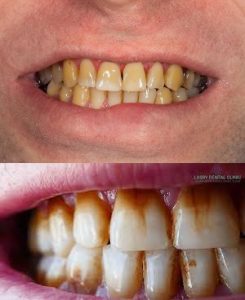
People get their teeth stained and there are a lot of reasons why, though the reasons might differ. Stay tuned to Labaranyau.com for more insight and the causes and remedy to teeth stains.
The embedded video below is a detail explanation of how to clean up your teeth from stains.
Some of this Food includes:
Chocolates: Generally, most people love taking chocolate. When consumed in moderation, it’s the ultimate feel-good food, as evidenced by research showing its beneficial impact on mood and overall well-being.
Our teeth, however, do not enjoy chocolate, even though our thoughts may.
Though regular consumption of small amounts of chocolate (especially dark types) has many health benefits, chocolate consumption, like that of other sweet foods, can be harmful to your teeth.
Especially with milk chocolate variants, which contain a lot more sugar than dark chocolate, this is true.
It supplies the mouth with large amounts of sugar, which promotes the formation of bacteria, plaque, and gum disease.
Dental enamel is eroded by acids produced by bacteria in the mouth from sugar.
Tooth decay and cavities are caused by this.
Enamel weakness is made worse by chocolate’s sugar content.
Chocolate stains teeth.
Soy (Soya Bean): It may not be good news for lovers of Chinese and Japanese food since too much soy sauce might discolor teeth. Because soy sauce is so concentrated, it has the ability to discolor your teeth more than any other black liquid!
Moreover, soy sauce contains a lot of sodium.
When you consume tofu, you might not see any actual darkening on your teeth, although soy products do contain some acidity. Your staining may get more intense if you combine them with curry or soy sauce such as Awara or Wara mostly consumed in Northern Nigeria and Part of Niger Republic In Africa.
Tomato: Pasta sauce, Stew, and Ketchup with a tomato basis is one of the worst offenders when it comes to discolored teeth. Because of their high acidity and bright red color, tomatoes are a great source of discoloration for your teeth every time you eat spaghetti, macaroni, rice, and Tofu sauce, with a tomato basis. Before consuming tomato sauce, think about topping your pasta with a white sauce or having a salad made of dark green veggies like spinach, Ogwu Leaf, Onion leaves, American leaf, kale, or broccoli.
These veggies coat your teeth in a protective layer that minimizes the staining power of the tomatoes.
We mostly enjoy our food with ketchup stew or tomato sauce. The reddish look makes a plate of served food beautiful but always try to add some veggies in the food or consume the food with salad which can help reduce the power of discoloration of teeth.
Curry: Curry-As most of us are aware, eating foods high in pigment can cause discolouration of the teeth over time. Therefore, curries don’t seem dangerous because of their light and vibrant colour. Be not deceived. Curry powder is a very light colour, but with time, the deep pigment in curry will cause your teeth to get discolored. based dishes will leave your teeth stained with the same yellow tint.
Green leafy vegetables along with a curry dish will help prevent discoloration. To lessen the stain, rinse your mouth with water after eating curry and clean your teeth 30 minutes later. We are not recommending avoiding curries since they are tasty.
Coffee: Coffee, like any other non-water beverage, can produce bacteria in your mouth that erodes teeth and enamel. Your teeth may become thin and fragile as a result of this.
Coffee’s tendency to adhere to the tongue can also result in halitosis or bad breath. If you find it difficult to begin your day without having a cup (or two) of coffee, then removing enamel stains will be an ongoing struggle. Coffee can leave your teeth stained unpleasantly. Please refrain from adding a tonne of flavors or sweets, as this can exacerbate the situation for your teeth.
Tea
Teeth and gums naturally become stained by tannins included in Teas like Arabian tea, Nigerien Tea, Maiduguri tea, and other green and black herbal teas. While black tea leaves a yellowish stain on teeth, green tea leaves a dull grey stain.
Herbal teas like hibiscus and chamomile can also discolor teeth if drunk often over time. According to some research, tea’s propensity to discolor teeth may be lessened by adding a dash of milk or cream.
Cigarettes Smoking Discolored The Teeth
The first point of access into your body is through your mouth in between the upper and the lower lip. You most likely don’t consider how smoking may affect your teeth when you light up and take your first inhale. The amount of smoke you inhale, Your teeth’s general health, and your look are both impacted badly by cigarette smoking.
You lose the chance to keep your teeth naturally white if you smoke a pack of cigarettes a day. It’s helpful to picture your teeth as a porcelain vase. Your teeth’s enamel functions much like a porcelain finish with tiny flaws in it. The things you put in your mouth get absorbed by the cracks in your teeth as you age and utilize them for many years.
The tar and nicotine in cigarettes seep into crevices and settle there when you smoke them. It is impossible to ignore them. Poor brushing practices are not the only cause of stained teeth. Additionally, because cigarettes include tar and nicotine, they will cause plaque and tartar to accumulate on your teeth.
Teeth whitening is necessary if you smoke regularly to keep your smile bright and beautiful.
Nicotine and tobacco particles can enter your teeth when you smoke. Bad breath and discolored, yellow teeth are therefore likely to occur.
Furthermore, smoking impairs your perception of taste more the more you smoke. Your teeth are also impacted by what you eat and drink.
Additionally, smoking might weaken your immune system, increasing your risk of gum disease and oral cancer.
Poor Oral Hygiene Discolorate The Teeth
You may be surprised by how much better dental hygiene can take care of your mouth. Saliva repeatedly aids in maintaining the pH equilibrium in your mouth. Oral diseases can lead to a variety of detrimental health effects. You would never believe that if prompt treatment is not received, even a little cavity might become a significant issue. It is plausible that the infection will manifest in regions where dental caries escalate, consequently resulting in abscesses and pus.
Aging Is A Trigger To Teeth Discoloration
It is common knowledge that as a man grows older, his health and physical body depreciate slowly with time. Sadly, your teeth are not in the same category. A variety of dental issues, such as discoloration and yellowing, are frequently associated with aging. Although the effects of aging on your teeth cannot be completely reversed, there are steps you may take to mitigate their consequences.
The healthiest of teeth can become stained after years of exposure to highly pigmented foods and beverages like wine, coffee, and berries. Consider it like this. The likelihood is that it will discolor your teeth if it stains your clothing. Additionally, smoking is a factor in teeth discoloration and yellowing.
Your teeth will naturally turn yellow with age, even if you avoid meals and tobacco products that contain pigment. This is because as time passes, wear and tear causes the outer layer of enamel to thin, exposing the yellow-colored dentin underneath. Furthermore, when teeth age, the tiny holes in the enamel that naturally develop in them enlarge, making the teeth more vulnerable to discoloration and staining.
How To Go About Teeth Discoloration
Good Oral Hygiene: Maintaining a healthy, disease-free mouth is known as oral hygiene. It entails cleaning and flossing your teeth in addition to routinely seeing your dentist for examinations, cleanings, and X-rays.
Preventive care includes practicing good oral hygiene. By taking appropriate care of your teeth and gums by brushing two to three times daily, you can prevent oral health problems like cavities, gum disease, bad breath (halitosis), and other concerns before they arise.
Whole-body wellness is also associated with dental health. For instance, if you have a mouth infection, the bacteria may enter your bloodstream and spread to other parts of your body, increasing your risk of developing heart disease and stroke. Maintaining long-term general health requires taking good care of your teeth and gums.
Avoid Consuming Stain-Causing Food: You should eliminate some foods from your diet for both health-related concerns and to prevent tooth discoloration. You can, for instance, give up soda and candy. Your body will appreciate you consuming less acid and sugar.
Avoid Smoke: Your dentist or physician may be able to provide you with medicine, like nicotine gum and patches, to help you curb your cravings for tobacco use. A prescription is needed for some of these products, while others are available over-the-counter. Certain drugs, including Zyban, need a prescription which helps in the avoidance of teeth discoloration.
Timely Dental Check-Ups: Dentists examine patients’ teeth for early indications of dental decay. To prevent further decay, a dentist will frequently advise fluoride therapy if white patches or tiny cavities are seen on the teeth. If larger cavities are discovered, dental fillings will be used to treat them at a later session.
To remove any remaining plaque or tartar, the dentist will also give the teeth a thorough cleaning. By doing this, the teeth and gums will be shielded from dangerous microorganisms that can cause decay.
Poor oral health can lead to problems with tooth decay, bad breath, and periodontal disease if these routine examinations are skipped.
Whitening Treatment: You will need to visit the dentist two or three times to get your teeth whitened.
To create a mouthguard, the dentist will take an impression of your teeth and instruct you on how to use bleaching gel with it. Then, for a few weeks, you apply the gel regularly at home with your mouthguard for a predetermined amount of time. The duration of therapy may be shortened by using some whitening gels, which can be left on for up to eight hours at a time.
Another kind of teeth-whitening method that a dentist might offer is laser whitening, commonly referred to as power whitening. Your teeth are coated with a bleaching solution, and the whitening process is then activated by shining a light or laser on them. It takes roughly an hour for laser whitening.
Discover more from Labaran Yau
Subscribe to get the latest posts sent to your email.



















